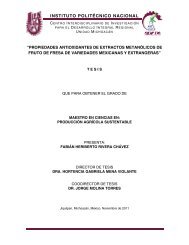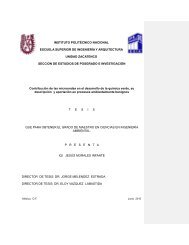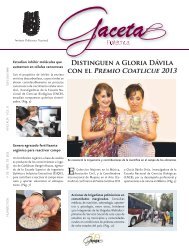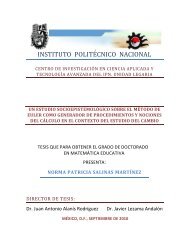Ver/Abrir - Repositorio Digital - Instituto Politécnico Nacional
Ver/Abrir - Repositorio Digital - Instituto Politécnico Nacional
Ver/Abrir - Repositorio Digital - Instituto Politécnico Nacional
You also want an ePaper? Increase the reach of your titles
YUMPU automatically turns print PDFs into web optimized ePapers that Google loves.
RESUMEN.<br />
En la presente tesis se desarrolla la construcción de un modelo<br />
estocástico para el análisis de escurrimientos sintéticos en la cuenca del Río<br />
Copalita. Los escurrimientos sintéticos fueron utilizados para hacer un análisis<br />
de incertidumbre en la gestión del agua en la cuenca mediante el uso del<br />
modelo de gestión WEAP para la cuenca del Rio Copalita. Como ejemplo de<br />
este análisis se creó un escenario en el cual se evalúa el abastecimiento de<br />
agua para requerimientos ambientales en las estaciones climatológicas de San<br />
Miguel Suchixtepec, Pluma Hidalgo y San Francisco Ozolotepec, así como la<br />
estación hidrométrica La Hamaca.<br />
El software que se utilizó para la construcción del modelo estocástico es<br />
el Stochastic Analysis Modeling and Simulation 2009 (SAMS 2009), el cual es<br />
un software que fue desarrollado en Colorado State University. Los datos de<br />
entrada abarcan un periodo de 32 años, de 1962 a 1993. Este modelo se utilizó<br />
para generar 1,000 series de escurrimientos sintéticos, cada serie con un<br />
periodo de 32 años. Se realizó un análisis estadístico a la media anual de las<br />
1,000 series generadas. De este análisis se seleccionaron 10 series<br />
representativas, las cuales abarcan diferentes condiciones hidrológicas: Sequia<br />
severa y moderada, condiciones normales, condiciones abundantes extremas<br />
y moderadas. Los resultados demuestran que en un periodo de recurrencia de<br />
8 años, pueden surgir problemas de abastecimiento.<br />
ABSTRACT.<br />
In this thesis develops the construction of a stochastic model for the<br />
analysis of synthetic runoff in the watershed of Rio Copalita. The synthetic<br />
runoff were used for analysis of uncertainty in water management in the<br />
watershed using the WEAP management model for the watershed of Rio<br />
Copalita. As an example of this analysis was created a scenario in which to<br />
evaluate the water supply for environmental requirements in the weather<br />
stations of San Miguel Suchixtepec, Pluma Hidalgo and San Francisco<br />
Ozolotepec, and hydrometric station La Hamaca.<br />
The software used for the construction of the stochastic model is The<br />
Stochastic Analysis Modeling and Simulation 2009 (SAMS 2009), which is<br />
software that was developed at Colorado State University. The input data cover<br />
a period of 32 years, from 1962 to 1993. This model was used to generate<br />
synthetic runoff 1.000 series, each series with a period of 32 years. A statistical<br />
analysis was realized to the annual average of 1:000 generated series. From<br />
this analysis there were selected 10 representative series, which include<br />
different hydrological conditions: severe and moderate Drought, normal<br />
conditions, abundant extreme and moderate conditions. The results show that a<br />
recurrence period of 8 years, supply problems can arise.<br />
8

















